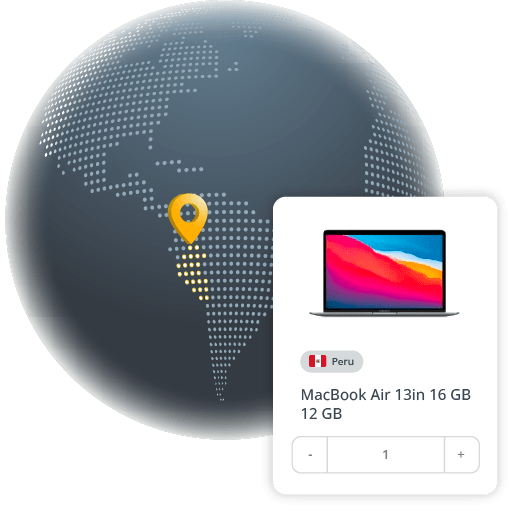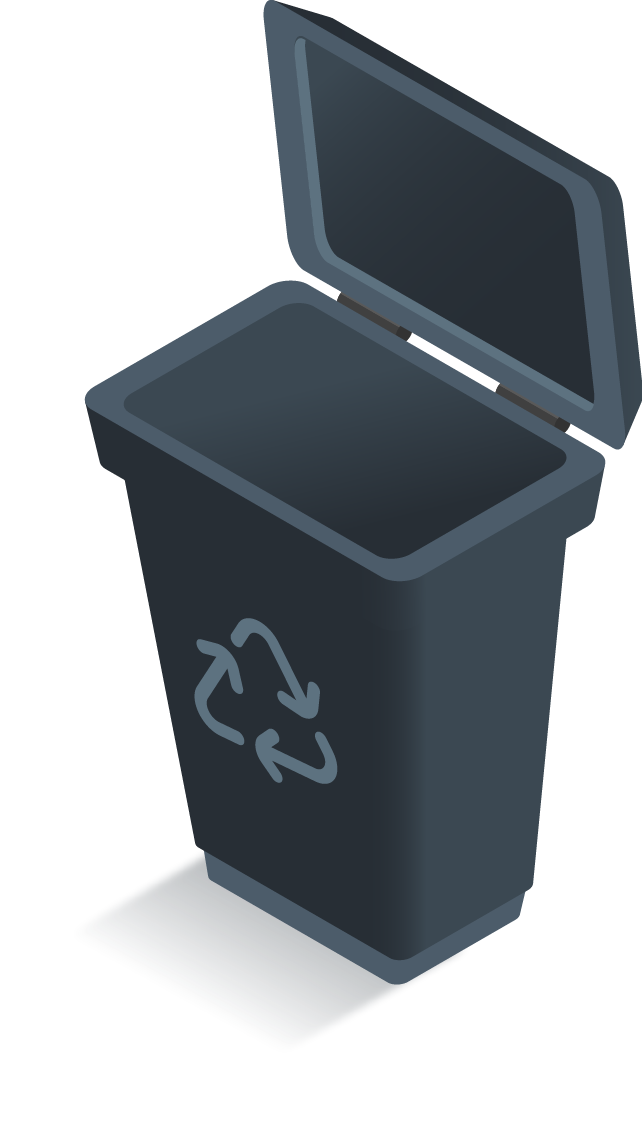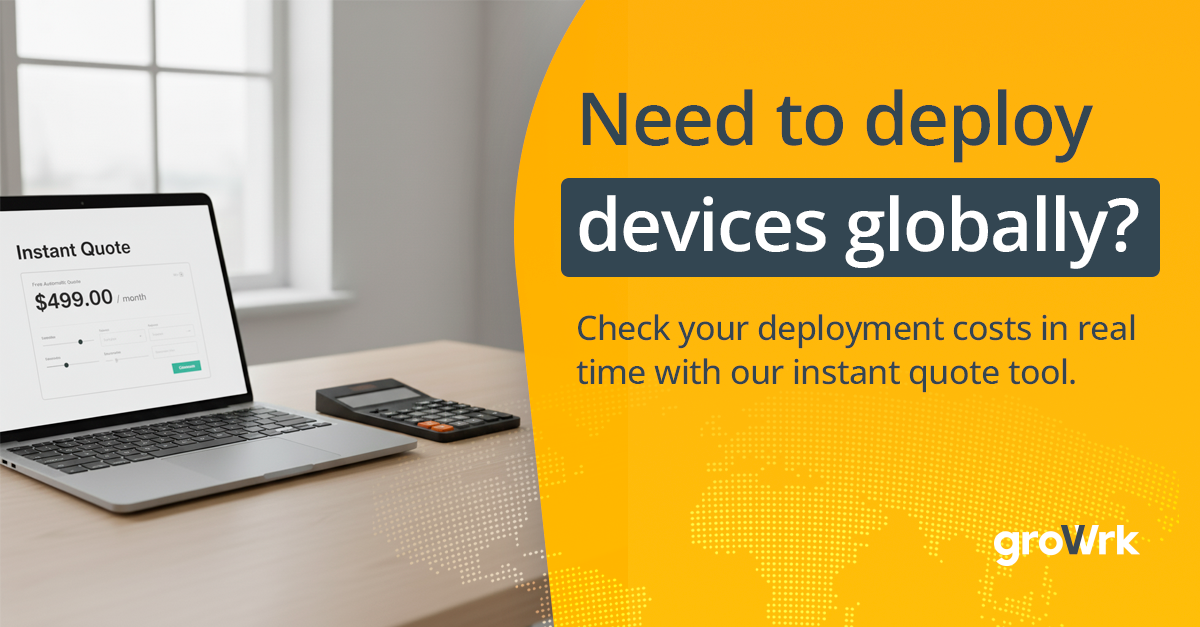How to send IT equipment to Peru
Looking to send Laptops or other IT equipment to distributed teams in Peru? GroWrk simplifies IT asset management, shipping, and compliance across borders. Learn how to seamlessly manage logistics, customs, and IT outsourcing for your remote team.

At a glance
Peru’s IT sector is expanding rapidly, driven by digital transformation, government initiatives, and a growing tech-savvy workforce. Understanding the IT ecosystem is essential for businesses planning to enter the Peruvian market and leverage its emerging opportunities in cloud computing, AI, and software development.
|
CURRENCY Peruvian Sol (PEN) |
OFFICIAL LANGUAGE Spanish |
TIME ZONE UTC−05:00 |
|
CUSTOMS DUTY ON ELECTRONICS Peru has a free trade agreement with the United States, which eliminates tariffs on many electronic products. However, import duties may still apply to certain items, and it's advisable to consult the latest customs regulations or a customs broker for specific information. |
SHIPPING LEAD TIME 7-14 days (depending on location and shipping method) |
IT OUTSOURCING MARKET The IT outsourcing market in Peru is projected to grow by 9.08% between 2025 and 2029, reaching a market volume of approximately USD 856.40 million by 2029. |
Overview of IT operations in Peru

Digital Transformation: Peru is investing in digital technologies such as artificial intelligence, cloud computing, and data centers. The government's National Policy of Digital Transformation aims to increase the proportion of adults using digital technologies for accessing government services from 52% to 85% by 2030.
Government Initiatives: In 2024, Peru secured a €300 million credit from the German KfW Development Bank to fund a digital transformation program, underscoring the government's commitment to enhancing the country's digital infrastructure.
Skilled Workforce: Peru boasts a growing pool of IT professionals, with over 38,000 developers contributing to a vibrant tech ecosystem. The country's innovative startup scene has attracted more than US$160 million in recent deals, highlighting its potential as a hub for software development and outsourcing.
IT Market Growth: The Peruvian ICT market was valued at US$9.90 billion in 2023 and is projected to grow at a compound annual growth rate (CAGR) of 11.12%, reaching US$16.77 billion by 2028. The increased adoption of digital technologies across various sectors drives this growth.
Geographical Advantage: Strategically located in Latin America, Peru offers access to regional markets and a growing consumer base, making it an attractive destination for IT operations and service delivery.
Shipping IT equipment to Peru: What you need to know
| Customs regulations |
Importing IT equipment such as laptops, servers, and networking devices into Peru requires compliance with SUNAT (National Superintendency of Customs and Tax Administration) regulations. Importers must be registered with SUNAT and obtain a Taxpayer Identification Number (RUC) to proceed with customs clearance. Additionally, a Customs Merchandise Declaration (Declaración Aduanera de Mercancías - DAM) must be submitted for all imported goods. Certain types of IT equipment, particularly telecommunication devices, may require additional approvals from the Ministry of Transport and Communications (MTC) before they can enter the country. |
| Duties and taxes |
|
| Required documentation |
|
| Import restrictions |
Certain high-tech items, including networking and telecommunications equipment, may require special permits from the Ministry of Transport and Communications (MTC) before they can be imported. Additionally, it is essential to verify with SUNAT whether any items are prohibited or restricted to avoid shipment rejections and potential delays in customs clearance. |
| New vs. Used equipment |
| The Peruvian government generally prohibits the importation of used consumer goods. Importing used laptops may be challenging and could require special permits or certifications. It's advisable to verify the regulations with SUNAT before attempting to import used IT equipment. |
| Penalties or fines for non-compliance |
|
Checklist for sending laptops to Peru
When shipping laptops to Peru, it’s important to follow a few best practices to ensure the process goes smoothly, and your equipment arrives safely and on time. Here are some helpful shipping tips:

Select trusted couriers: Choose reliable couriers such as GroWrk, DHL, UPS, FedEx, or Serpost (Peru's national postal service) for international shipping. These carriers offer tracking services and have experience handling Peruvian customs procedures.
Check service levels: Select the appropriate shipping option based on urgency. Express shipping (3-6 days) for high-priority deliveries. Standard shipping (7-14 days) for cost-effective options.
Use high-quality packaging: Secure laptops with sturdy, padded boxes and protective materials like bubble wrap, foam inserts, or air cushions to prevent damage during transit.
Disassemble where possible: If shipping accessories like chargers, docking stations, or monitors, package them separately to prevent damage. Remove detachable components if applicable.
Label clearly: Ensure the recipient’s name, address, and contact details are correctly labeled. Mark the package as "fragile" to encourage careful handling.
Accurate product descriptions: On the commercial invoice, provide a detailed and accurate description of the laptop, including its brand, model, and serial number. Inaccurate descriptions may cause customs delays.
Value declaration: Declare the correct value of the laptop to avoid under- or over-declaring, which could lead to customs inspections or fines. The declared value determines any applicable duties and taxes.
Customs declarations: All international shipments require customs clearance. Include: Peruvian Customs Declaration (DUA or DSI, depending on the shipment type), commercial invoice, and packing list
Proof of origin: If applicable, include a certificate of origin to determine eligibility for preferential trade agreements, such as the Peru-United States Trade Promotion Agreement (PTPA) or other free trade agreements, which may reduce duties.
Understand import duties & taxes: Laptops are exempt from import duties in Peru but are subject to 18% IGV (General Sales Tax) on the declared value, including shipping costs. Customs processing fees may apply depending on the shipment value.
Pre-pay duties and taxes: Some couriers allow for pre-paid duties and taxes to simplify customs clearance and prevent the recipient from facing unexpected charges upon arrival.
Protect against loss or damage: Consider purchasing shipping insurance for high-value laptops to protect against loss, theft, or damage during transit.
Compliance with Peruvian regulations: Ensure compliance with Peru's telecommunications and electronic safety regulations, including MTC (Ministry of Transport and Communications) requirements, and verify if certification is needed for large shipments.
Use tracking tools: Major couriers provide real-time tracking—monitor shipments closely to anticipate customs clearance updates and delivery progress.
Stay in touch with the recipient: Notify the recipient about the expected delivery timeline, tracking updates, and any customs-related requirements to avoid delays.
Expect weather and seasonal delays: Weather conditions (e.g., heavy rains, flooding in certain regions) and peak shipping periods (e.g., Christmas, Black Friday) may cause delivery delays. Plan shipments accordingly.
Peruvian domestic delivery options: For final delivery, consider working with Serpost, Olva Courier, Shalom Express, or DHL Peru for efficient last-mile distribution.

Average cost of IT Equipment in Peru
Laptops (Business Grade):
- Mid-range: $650 - $1,400
- High-end: $1,400 - $2,600+
High-end models such as Apple MacBook Pro, Dell XPS, and Lenovo ThinkPad are priced on the higher end.
Monitors (Business Grade):
- Standard: $160 - $320
- Ultrawide/4K: $400 - $1,050
Monitors from trusted brands like Dell, Samsung, and LG typically range within these prices, with 4K or ultrawide models costing more.
Desktops (Business Grade):
- Standard Desktop PC: $500 - $1,600
- Workstation Desktop (for high-performance tasks): $1,600 - $3,700+
Prices depend on the brand and specifications, with options from HP, Lenovo, and Apple among the most common.
Printers (Laser):
- Standard Office Printers: $160 - $420
- High-Volume Printers: $500 - $1,800+
Leading brands such as HP, Canon, and Brother offer a wide range of models for office environments.
Public holidays & IT work hours to plan your shipment
Key public holidays in Peru:
- New Year's Day (Año Nuevo): January 1
- Maundy Thursday (Jueves Santo): April 17, 2025
- Good Friday (Viernes Santo): April 18, 2025
- Labour Day (Día del Trabajo): May 1
- Flag Day (Día de la Bandera): June 7
- Feast of Saints Peter and Paul (San Pedro y San Pablo): June 29
- Independence Day (Día de la Independencia): July 28–29
- Santa Rosa de Lima Day (Día de Santa Rosa de Lima): August 30
- Battle of Angamos (Batalla de Angamos): October
- All Saints' Day (Día de Todos los Santos): November 1
- Immaculate Conception (Inmaculada Concepción): December 8
- Christmas Day (Navidad): December 25
Typical work hours for IT professionals
- Standard Working Hours: The maximum legal workday is eight hours, totaling up to 48 hours per week.
- Overtime Compensation: Work exceeding these standard hours is considered overtime and must be compensated accordingly. The first two hours of overtime are remunerated at a rate of 25% above the regular hourly wage, and any additional hours are compensated at a rate of 35% above the regular hourly wage.
- Rest Periods: Employees are entitled to a minimum uninterrupted break of at least 45 minutes for lunch if they work a continuous schedule. This break is not considered working time unless otherwise stipulated in a collective agreement.
- Weekly Rest: All workers are entitled to a minimum of 24 consecutive hours of paid weekly rest, which typically falls on Sunday. Through collective agreement, employees can accumulate their weekly rest for up to two consecutive weeks.
What to consider when retrieving IT equipment from employees in Peru
| Local delivery and logistics services |
|
| Inventory management |
|
| Logistics challenges for remote locations |
|
| Equipment agreement with employees |
|
How to dispose of IT equipment in Peru
E-waste recycling
IT equipment such as laptops, monitors, and other electronics must be disposed of through certified e-waste recycling programs. Peru has established regulations for managing Waste Electrical and Electronic Equipment (WEEE), emphasizing the responsibilities of producers, distributors, and operators in collecting and properly disposing electronic waste. The Ministry of Environment (MINAM) oversees these regulations, including implementing WEEE management systems and submitting management plans.
Data destruction
Before disposing of or repurposing any IT equipment, please make sure that all sensitive data is completely erased to comply with data protection laws. Data destruction should be performed using certified methods, such as data wiping software or physical destruction of hard drives, to prevent unauthorized access to confidential information. Partnering with certified e-waste recyclers can ensure that data destruction is handled securely.
Repurposing or donating
If the equipment is still functional, consider repurposing it internally or donating it to educational institutions, non-profits, or other organizations. This approach not only extends the useful life of the equipment but also supports community initiatives and reduces environmental impact. Ensure that any donated equipment is free of sensitive data and in good working condition.

Local IT Outsourcing Solutions in Peru
You can streamline your IT logistics and asset management with GroWrk’s comprehensive global solution. Whether it’s shipping equipment or managing IT assets across multiple regions, GroWrk helps you stay compliant and efficient, every step of the way. Here’s why GroWrk is the ideal partner for managing your IT assets in Peru:

| 1. Wide global coverage |
| With operations in over 150 countries, including Peru, GroWrk guarantees seamless IT deployment and management for remote teams. Whether your employees are in Lima, Arequipa, Trujillo, or remote locations, we ensure timely and hassle-free service to keep your business running smoothly. |
| 2. End-to-end asset management |
GroWrk simplifies the entire IT asset lifecycle, covering procurement, deployment, management, and retirement. By handling logistics, compliance, and security, we allow your team to focus on business growth while we manage IT operations. |
| 3. Intuitive platform for easy deployment |
Our user-friendly platform makes it effortless to order, ship, and track IT equipment across Peru. Employees receive pre-configured, ready-to-use devices, reducing administrative overhead and ensuring seamless onboarding. |
| 4. Smooth delivery and equipment retrieval |
From delivering laptops, monitors, and IT accessories to remote employees across Peru to retrieving assets from departing team members, GroWrk handles it all. We make the process efficient and fully traceable, eliminating logistical challenges. |
| 5. Compliance with Peruvian import regulations |
Peru has strict customs, tax, and compliance requirements for IT shipments. GroWrk ensures SUNAT regulations, WEEE disposal, and tax compliance, preventing delays, penalties, or unexpected costs. |
| 6. Efficient repairs and maintenance |
We manage hardware repairs, replacements, and maintenance to keep IT assets in top working condition. Whether through on-site servicing or remote troubleshooting, GroWrk minimizes downtime and ensures business continuity. |
| 7. 24/7 Support for peace of mind |
From shipping assistance and compliance management to real-time troubleshooting, GroWrk’s 24/7 support ensures smooth IT operations, keeping your remote workforce in Peru fully equipped. |
Procure, configure, and deploy your IT devices from one platform


